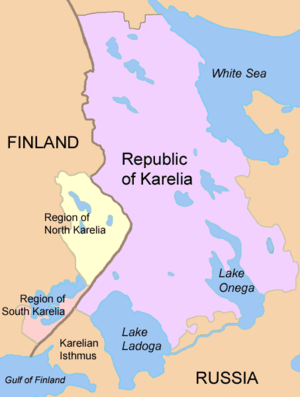Karelia
|
|
- This article is about Karelia, the land of the Karelians, in its broadest meaning. See Karelia (disambiguation) for other and more specific usages.
Many_Karelias.png
Karelia is the land of the Karelian people, that inhabitated vast areas in Northern Europe, of historical significance for Finland, Russia and Sweden. It is currently divided between the Russian Republic of Karelia, the Russian Leningrad Oblast, and two Regions of Finland, South Karelia and North Karelia.
In the Karelian and Finnish languages Karelia is called Karjala; in Russian Карелия, and in Swedish Karelen.
| Contents |
History
Main article: History of Karelia
Karelia was bitterly fought over by Sweden and Novgorod in the 13th century. The Treaty of Nöteborg in 1323 divided Karelia between the two. Vyborg became the capital of the new Swedish province.
The Treaty of Nystad in 1721, between Imperial Russia and Sweden, ceded most of Karelia to Russia. After Finland had been conquered by Russia in the Finnish War, parts of the ceded provinces (Old Finland) were incorporated into the Grand Duchy of Finland. In 1917 Finland became independent and the border was confirmed by the Treaty of Tartu in 1920.
During the 1920s, Finns were involved in attempts to overthrow the Bolshevists in Russian Karelia (East Karelia), for instance in the failed Aunus expedition.
After the end of the Russian Civil War, and the establishment of the Soviet Union in 1922, the Russian part of Karelia became the Karelian Autonomous republic of the Soviet Union (ASSR) in 1923.
In the 1940s, most of Finnish Karelia was first ceded to the Soviet Union in the Peace of Moscow that followed the Winter War (1939–1940), then re-conquered for three years during the Continuation War 1941–1944 when also East Karelia was occupied by the Finns. The Winter War and the resulting Soviet expansion caused considerable bitterness in Finland that lost its second biggest city, Vyborg, its industrial heart along the river Vuoksi, the Saimaa canal that connected central Finland to the Gulf of Finland, access to the fishing waters of Lake Ladoga, and made an eighth of her citizens refugees without hope of return.
As a consequence of the Peace of Moscow, the Karelian ASSR was incorporated with the Karelo-Finnish SSR 1941–1956; After which it became an ASSR again.
In 1991 the Republic of Karelia was created of the ASSR.
Politics
Karelia is divided between Finland and Russia. The Republic of Karelia is an autonomous republic of Russia, which was formed in 1991 from the Karelian ASSR. The Karelian Isthmus belongs to the Leningrad Oblast. The Finnish parts of Karelia are part of the regions (maakunta) of South Karelia and North Karelia.
There are some small but fervent groups of Finns campaigning for closer ties between Finland and Karelia. Thus the irredentist hopes for Finland's re-acquisition of the lost Finnish Karelia live on in for instance the Karjala takaisin -movement. The ambitions for closer ties with East Karelia does usually not include territorial changes.
Geography
Main article: Geography of Karelia
NW_Russia.jpg
Karelia streches from the White Sea coast to the Gulf of Finland. It contains the two largest lakes in Europe, Lake Ladoga and Lake Onega. The Karelian Isthmus is located between the Gulf of Finland and Lake Ladoga.
The border between Karelia and Ingria, the land of the closely related Ingrian people, is traditionally held to follow the rivlet Sestra/Rajajoki (Russian: Сестра/Раяйоки), today in the Saint Petersburg metropolitan area, but 1812–1940 the Russo-Finnish border.
On the other side of Lake Ladoga, River Svir is usually thought of as the traditional southern border of Karelian land, like Lake Saimaa marks the Western border while Lake Onega and the White Sea marks the Eastern border. In the North there were the nomadic Samis, but no natural border except for huge woods (taiga) and tundra.
In historical texts Karelia is sometimes divided into East Karelia and West Karelia, which are also called Russian Karelia and Finnish Karelia respectively. The area to the north of Lake Ladoga which belonged to Finland before World War II is called Ladoga Karelia, and the parishes on the old pre-war border are sometimes called Border Karelia. White Karelia is the northern part of East Karelia and Olonets Karelia is the southern part.
Tver Karelia denotes the villages in the Tver Oblast that are inhabited by Karelians. [1] (http://www.kotus.fi/verkkojulkaisut/julk129/karjala_suomen.shtml) [2] (http://www.kotus.fi/verkkojulkaisut/julk129/karjala_venajan.shtml)
Towns and cities
- in the Republic of Karelia
- Petrozavodsk (Петрозаводск, Petroskoi)
- Medvezhyegorsk (Медвежьегорск, Karhumäki)
- Kalevala (Калевала, Uhtua)
- Kem (Vienan Kemi, compare with Kemi)
- Kostomuksha (Kostamus)
- Kondopoga (Кондопога, Kontupohja)
- Sortavala (Сортавала)
- Segezha (Сегежа)
- Unitsa (Уница)
- on the Karelian Isthmus
- in South Karelia
- Imatra
- Lappeenranta (Villmanstrand)
Demographics
The Karelian language is spoken in the Republic of Karelia and also in the Tver Karelian villages. The Veps language is spoken on both sides of the River Svir. The dialect spoken mainly in South Karelia is part of the South-Western dialects of Finnish. [3] (http://www.internetix.ofw.fi/opinnot/opintojaksot/8kieletkirjallisuus/aidinkieli/murteet/kaakkois.html) The dialect in North Karelia is part of the large group of Savonian dialects. [4] (http://www.internetix.ofw.fi/opinnot/opintojaksot/8kieletkirjallisuus/aidinkieli/murteet/savolais.html) Karelians who evacuated from Finnish Karelia resettled all over Finland and today there are approximately one million people in Finland having Karelian roots. In Finland, about 5,000 people speak Karelian.
Culture
Main article: Culture of Karelia
External links
- Karelians (http://www.eki.ee/books/redbook/karelians.shtml) (The Peoples of the Red Book)
- The Many Karelias (http://virtual.finland.fi/finfo/english/karjala.html) - Virtual Finland
de:Karelien en:Karelia et:Karjala fi:Karjala fr:Carélie it:Carelia ko:카르얄라 ja:カレリア nl:Karelië pl:Karelia ru:Карелия sv:Karelen tt:Kareliä zh:卡累利阿共和国

